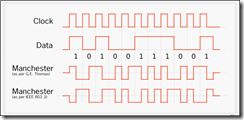曼彻斯特码(From Wikipedia )
Manchester code
Manchester code (also known as Phase Encoding, or PE) is a line code in which the encoding of each data bit has at least one transition and occupies the same time.
It is self-clocking, which means that it may be inductively or capacitively coupled, and that a clock signal can be recovered from the encoded data.
Manchester code is widely used (e.g. in Ethernet; see also RFID or Near Field Communication).
Features
Manchester code ensures frequent line voltage transitions, directly proportional to the clock rate; this helps clock recovery.
The DC component of the encoded signal is not dependent on the data and therefore carries no information, allowing the signal to be conveyed conveniently by media (e.g. Ethernet) which usually do not convey a DC component.
Description
Summary:
Each bit is transmitted in a fixed time (the "period").
A 0 is expressed by a low-to-high transition, a 1 by high-to-low transition (according to G.E. Thomas' convention -- in the IEEE 802.3 convention, the reverse is true).
The transitions which signify 0 or 1 occur at the midpoint of a period.
Transitions at the start of a period are overhead and don't signify data.

